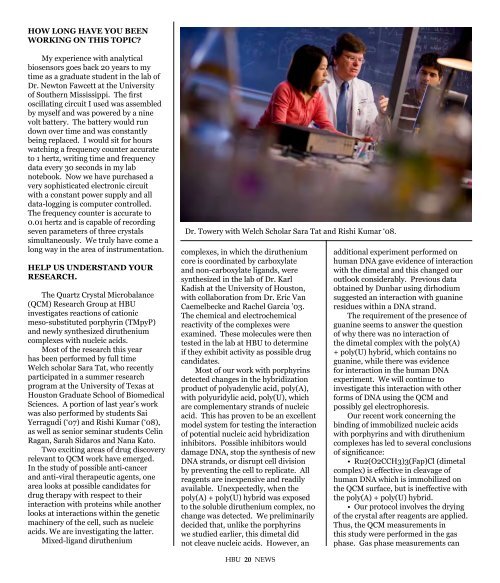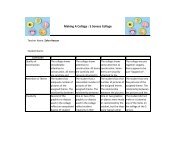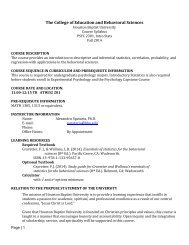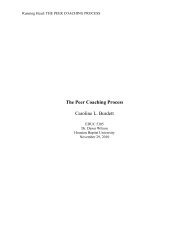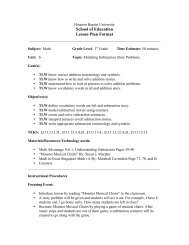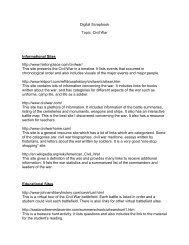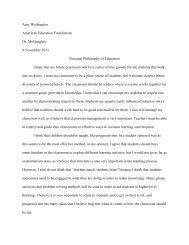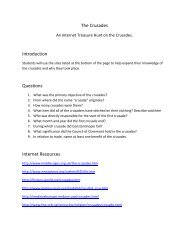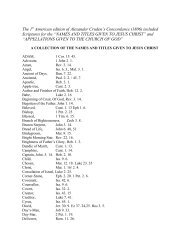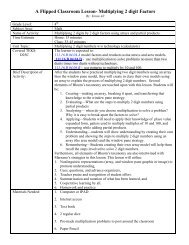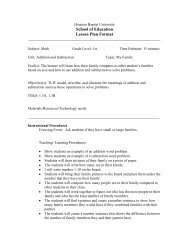Volume 46, #1 - November 2008 - Houston Baptist University
Volume 46, #1 - November 2008 - Houston Baptist University
Volume 46, #1 - November 2008 - Houston Baptist University
Create successful ePaper yourself
Turn your PDF publications into a flip-book with our unique Google optimized e-Paper software.
HOW LONG HAVE YOU BEENWORKING ON THIS TOPIC?My experience with analyticalbiosensors goes back 20 years to mytime as a graduate student in the lab ofDr. Newton Fawcett at the <strong>University</strong>of Southern Mississippi. The firstoscillating circuit I used was assembledby myself and was powered by a ninevolt battery. The battery would rundown over time and was constantlybeing replaced. I would sit for hourswatching a frequency counter accurateto 1 hertz, writing time and frequencydata every 30 seconds in my labnotebook. Now we have purchased avery sophisticated electronic circuitwith a constant power supply and alldata-logging is computer controlled.The frequency counter is accurate to0.01 hertz and is capable of recordingseven parameters of three crystalssimultaneously. We truly have come along way in the area of instrumentation.HELP US UNDERSTAND YOURRESEARCH.The Quartz Crystal Microbalance(QCM) Research Group at HBUinvestigates reactions of cationicmeso-substituted porphyrin (TMpyP)and newly synthesized dirutheniumcomplexes with nucleic acids.Most of the research this yearhas been performed by full timeWelch scholar Sara Tat, who recentlyparticipated in a summer researchprogram at the <strong>University</strong> of Texas at<strong>Houston</strong> Graduate School of BiomedicalSciences. A portion of last year’s workwas also performed by students SaiYerragudi (‘07) and Rishi Kumar (‘08),as well as senior seminar students CelinRagan, Sarah Sidaros and Nana Kato.Two exciting areas of drug discoveryrelevant to QCM work have emerged.In the study of possible anti-cancerand anti-viral therapeutic agents, onearea looks at possible candidates fordrug therapy with respect to theirinteraction with proteins while anotherlooks at interactions within the geneticmachinery of the cell, such as nucleicacids. We are investigating the latter.Mixed-ligand dirutheniumDr. Towery with Welch Scholar Sara Tat and Rishi Kumar ‘08.complexes, in which the dirutheniumcore is coordinated by carboxylateand non-carboxylate ligands, weresynthesized in the lab of Dr. KarlKadish at the <strong>University</strong> of <strong>Houston</strong>,with collaboration from Dr. Eric VanCaemelbecke and Rachel Garcia ’03.The chemical and electrochemicalreactivity of the complexes wereexamined. These molecules were thentested in the lab at HBU to determineif they exhibit activity as possible drugcandidates.Most of our work with porphyrinsdetected changes in the hybridizationproduct of polyadenylic acid, poly(A),with polyuridylic acid, poly(U), whichare complementary strands of nucleicacid. This has proven to be an excellentmodel system for testing the interactionof potential nucleic acid hybridizationinhibitors. Possible inhibitors woulddamage DNA, stop the synthesis of newDNA strands, or disrupt cell divisionby preventing the cell to replicate. Allreagents are inexpensive and readilyavailable. Unexpectedly, when thepoly(A) + poly(U) hybrid was exposedto the soluble diruthenium complex, nochange was detected. We preliminarilydecided that, unlike the porphyrinswe studied earlier, this dimetal didnot cleave nucleic acids. However, anadditional experiment performed onhuman DNA gave evidence of interactionwith the dimetal and this changed ouroutlook considerably. Previous dataobtained by Dunbar using dirhodiumsuggested an interaction with guanineresidues within a DNA strand.The requirement of the presence ofguanine seems to answer the questionof why there was no interaction ofthe dimetal complex with the poly(A)+ poly(U) hybrid, which contains noguanine, while there was evidencefor interaction in the human DNAexperiment. We will continue toinvestigate this interaction with otherforms of DNA using the QCM andpossibly gel electrophoresis.Our recent work concerning thebinding of immobilized nucleic acidswith porphyrins and with dirutheniumcomplexes has led to several conclusionsof significance:• Ru2(O2CCH3)3(Fap)Cl (dimetalcomplex) is effective in cleavage ofhuman DNA which is immobilized onthe QCM surface, but is ineffective withthe poly(A) + poly(U) hybrid.• Our protocol involves the dryingof the crystal after reagents are applied.Thus, the QCM measurements inthis study were performed in the gasphase. Gas phase measurements canHBU 20 News


